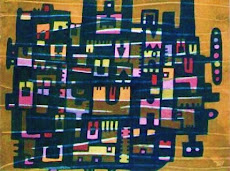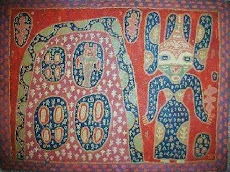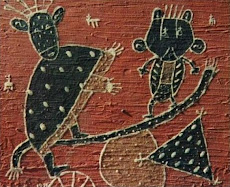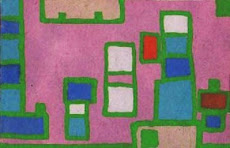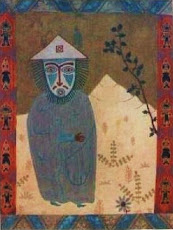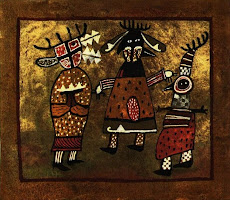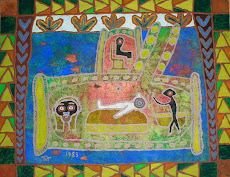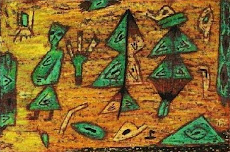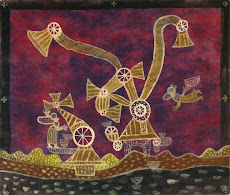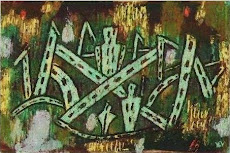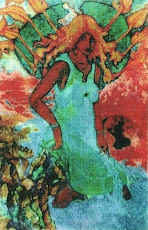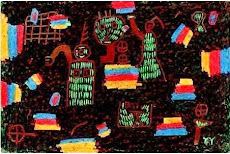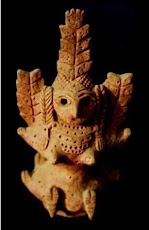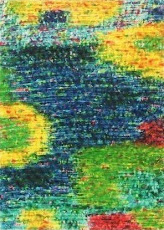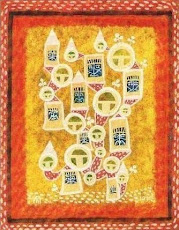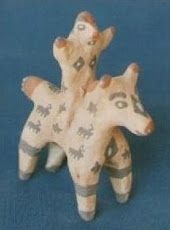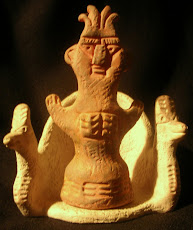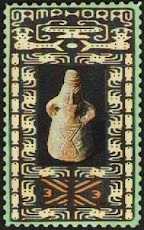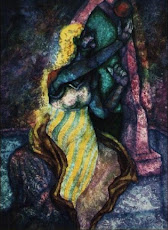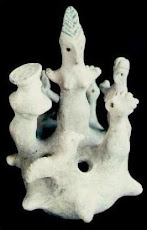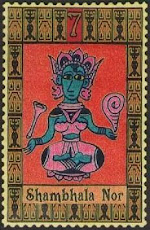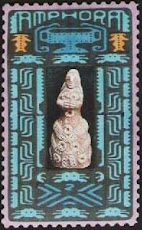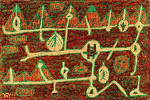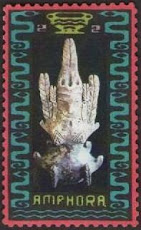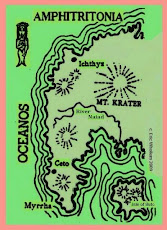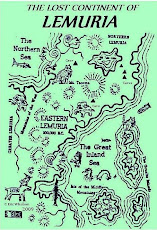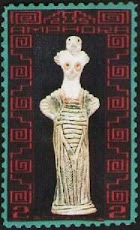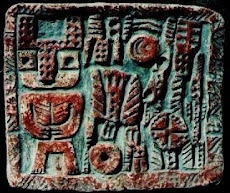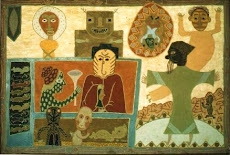Moon Cat
2004
by Eric Whollem
oxides on white earthenware clay~
flax cord
Private collection
PHOTO COPYRIGHT BY THE ARTIST
CLICK ON IMAGE TO ENLARGE
Ceramic Masks by Eric Whollem
Many readers, familiar with the ethnic arts of the Eskimos,
will notice design parallels with a number of the wall pieces
displayed on this blog post. The Eskimos are well-known for
a distinctive style of mask, which incorporates smaller fetishes
attached around the periphery of the piece.
I have attached clay fish and clay moons to a few of these works.
I utilize flax cord, which is a strong material, having been used
for centuries by sailors as a cord for patching canvas sails at
sea.
Feline Mask
2004
by Eric Whollem
oxides on white earthenware clay
Private collection
PHOTO COPYRIGHT BY THE ARTIST
CLICK ON IMAGE TO ENLARGE
Animal Mask
2004
by Eric Whollem
oxides on white earthenware clay~
flax cord
Private collection
PHOTO COPYRIGHT BY THE ARTIST
CLICK ON IMAGE TO ENLARGE
Medicine Animals
Many cultures have the concept of the medicine animal.
Not just shamans, but normal individuals, may identify
with certain animals out of a feeling of harmony with the
habits and characteristics of the respective animal.
I designed the above animal masks when I had my studio
in the remote reaches of the forests of the Sierra Nevada
Mountains. My nearest neighbors were a quarter of a mile
away. And to the north of my cabin, there were forty miles
of unpopulated forest before one would emerge on the Lake
Almanor area.
Many animals would come near my studio. A bear trail
ran next to the north wall. I would hear and see bobcats
repeatedly. I once viewed a lynx. And I have seen mountain
lions~ twice~very close to my cabin; and I heard their calls
quite often in the woodlands nearby.
I had a cat, Keetah, who was very sensitive to the proximity
of the animals that would come close. She would run upstairs
and growl near the window, if she sensed any danger. In this
respect she was an excellent guard animal. Dogs, as you know,
often bark, attracting attention. The cat is more discreet. In
Thailand, Buddhist monks have used Siamese cats for centuries
to guard their temples.
Fish Man
2004
by Eric Whollem
oxides on white earthenware clay~
flax cord
Private collection
PHOTO COPYRIGHT BY THE ARTIST
CLICK ON IMAGE TO ENLARGE
Fish Man
THE LORE OF THE AQUATIC SHAMAN
This mask is a fanciful interpretation of the concept of the
merman shaman. Historically the first mershaman was Ea, who
was a fish man who rose from the waters of the Persian Gulf.
He was a teacher of ettiquette and civilization to the peoples
of Mesopotamia. Ea's name means 'wisdom.' 'Ea' is related
etymologically to the Sanskrit word, 'jnana,' which means
knowledge.
THE DIVERS
The Eskimo shaman is called Angakok, which designation
means 'diver,' as the shaman's powers are symbolized by the
diving duck. The duck can fly high, but also dive deep into the
water. This symbolizes the penetration into all dimensions.
The shamans of Central Asia are also called divers. The
Huttorarie is one such shaman from the remote reaches of
Asia. Ethnologists have long noted that the peoples of Central
Asia are the ancestors of the Native American peoples.
Odin from Scandinavian lore is an example of a diety whose
transformative powers include taking on the form of a fish.
Odin could easily be interpreted as a shamanic being.
WOCTOLLY
Woctolly is the name of a merman shaman from Northern
California. The Maidu and Cato Indians of the Sierra Nevadas
and the Coast Range have tales of Woctolly. See my links at the
end of this post for my account of the legend of Woctolly.
Shaman's Mask
2004
by Eric Whollem
oxides on white earthenware clay~
flax cord
Private collection
PHOTO COPYRIGHT BY THE ARTIST
CLICK ON IMAGE TO ENLARGE
The Shaman's Mask
Mircea Eliade has one of the best accounts of the lore of the
shaman. His book, 'Shamanism,' is a classic and should not be
missed by those seeking an interesting and comprehensive
overview of the role of the shaman in world cultures.
Eliade made an excellent anthropologist, as he never deprecated
the cultures that he described. He was always respectful in his
observations.
The Central Asian Altai word, samana, is the basis of the English
word, shaman.
A video by Eric Whollem, 2011
___________________
My post about WOCTOLLY THE SALMON MERMAN can be found here:
Readers interested in my CERAMIC SCULPTURE should see:
CLICK ON IMAGES TO ENLARGE
GREEN FISH
ceramic wallpiece
by Eric Whollem
MANCO PAPAC
ceramic sculpture
by Eric Whollem
This link will take you to my articles on SHAMANISM:
This link will take you to my posts on ANTHROPOLOGY:
Those who enjoy MYTHOLOGY may want to see:
*






















